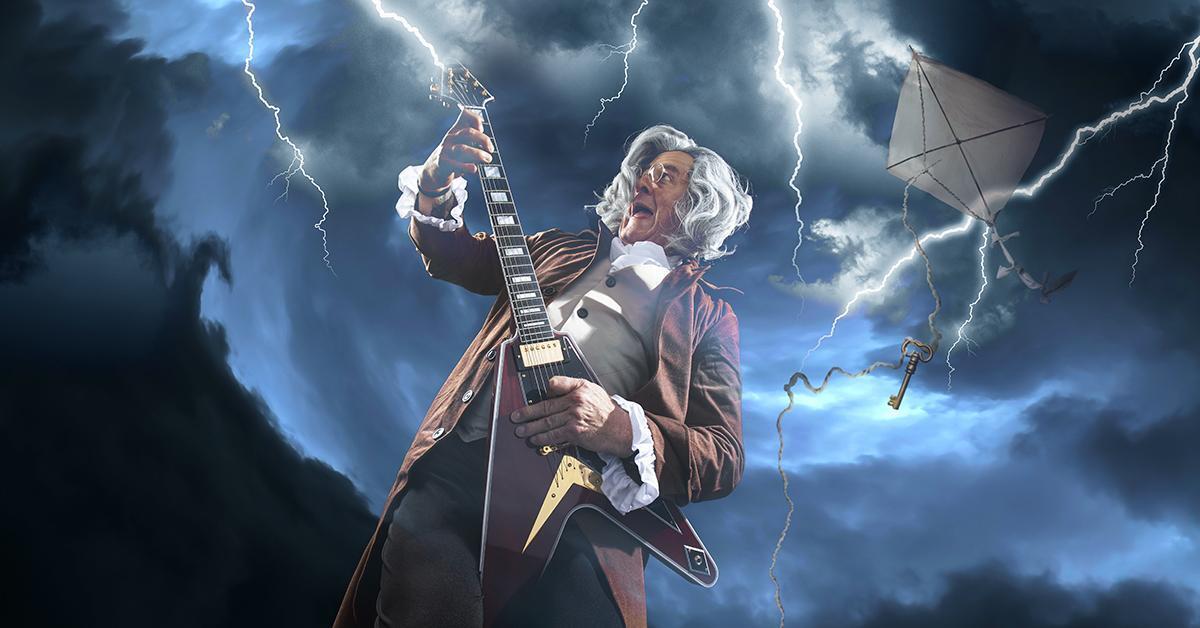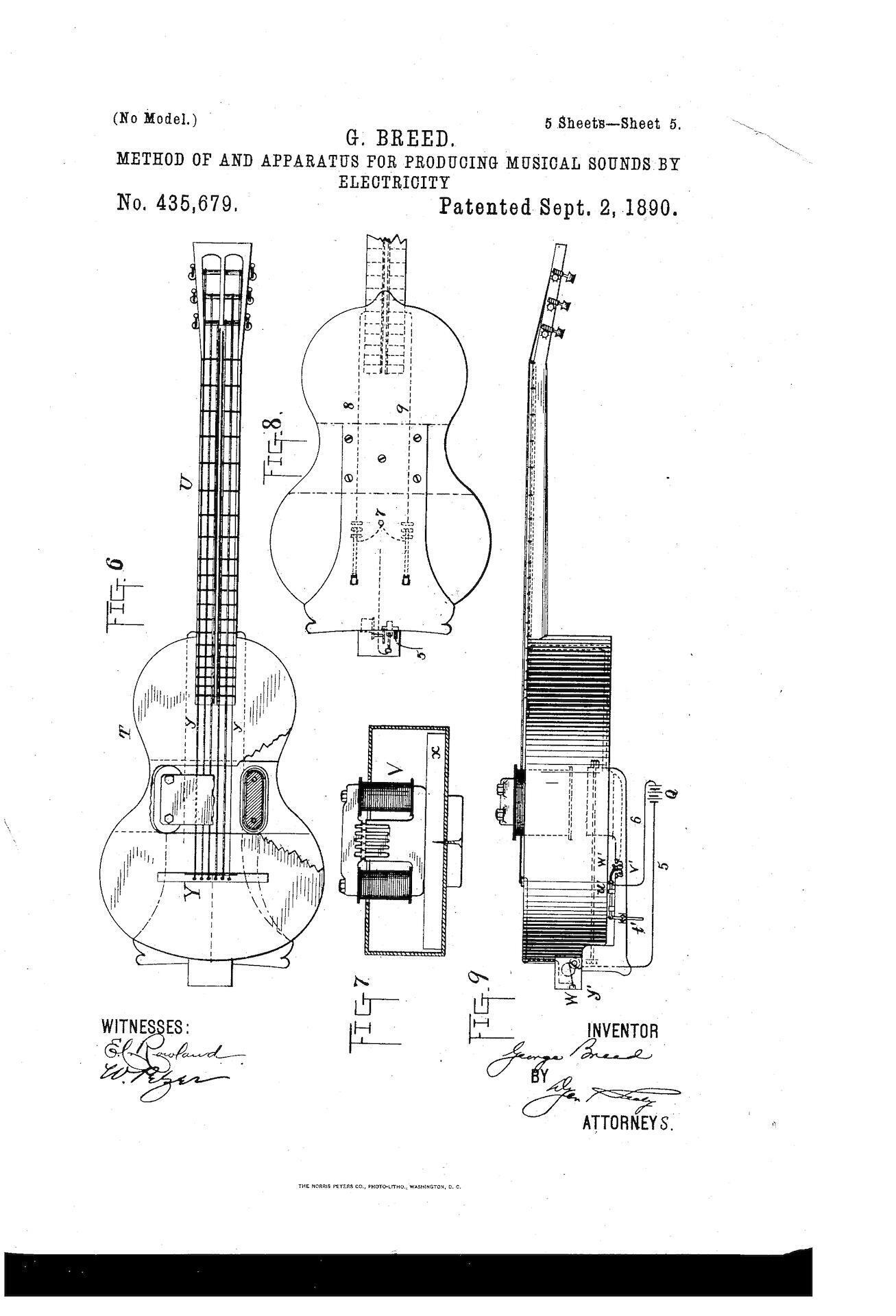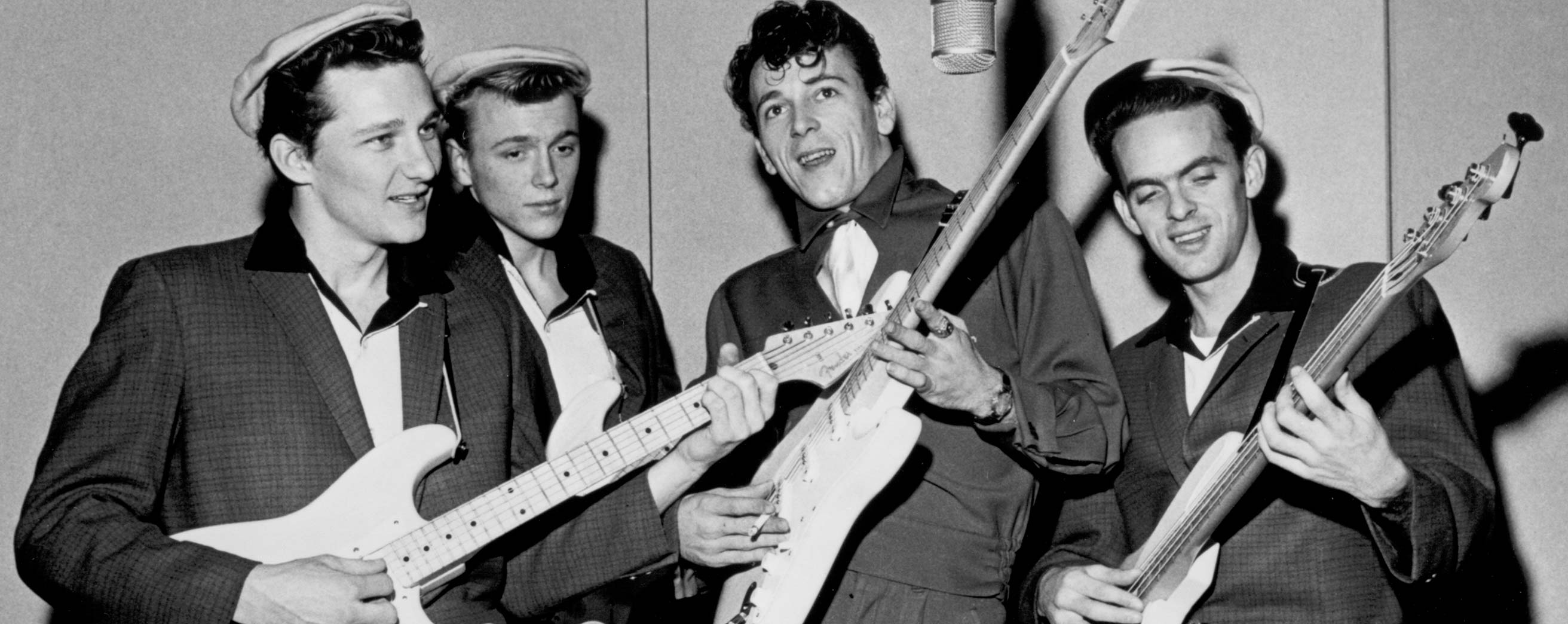Electric guitars emerged in the 1930s. Inventor George Beauchamp created the first successful model in 1931.
The electric guitar, a revolutionary instrument that transformed the music industry, began to gain prominence nearly a century ago. In 1931, George Beauchamp, alongside Adolph Rickenbacker, developed the first commercially viable electric guitar which forever altered the soundscape of music.
This innovation opened doors to new genres and playing techniques, allowing musicians to amplify their sound and capture the attention of larger audiences. The electric guitar’s growth paralleled the rise of blues, rock ‘n’ roll, and eventually rock, with its electrifying presence becoming a staple for performers and enthusiasts alike. Today, it stands as an icon of modern music, its history deeply entwined with the evolution of contemporary sound and culture.

Credit: www.sweetwater.com
Introduction To The Electric Guitar
Introduction to the Electric GuitarEmbark on a journey through the electrifying history of the electric guitar, an instrument that revolutionized music and culture. With its powerful sound and magnetic appeal, the electric guitar transformed performances, creating a new era for genres like rock, jazz, and blues. This icon of musical innovation emerged from a quest for volume and presence in the midst of big bands and orchestras, paving the way for a seismic shift in the musical landscape.
Origins of the Electric GuitarOrigins Of The Electric Guitar
The genesis of the electric guitar can be traced back to the early 1930s. As acoustic guitarists struggled to be heard over the din of ensembles, inventive minds began to experiment. Pioneers like Adolph Rickenbacker and George Beauchamp spearheaded this movement, culminating in the creation of the “Frying Pan”, the first commercially available electric guitar, around 1931. Table 1 delineates the key milestones in the evolution of the electric guitar:
Table: Key Milestones in the Evolution of the Electric Guitar| Year | Milestone |
|---|---|
| 1931 | Introduction of “Frying Pan” |
| 1936 | Gibson’s first electric guitar |
| 1950 | Fender releases the Broadcaster (later known as Telecaster) |
The Shift From Acoustic To Electric
The transition from acoustic to electric was not just technological; it also signified a cultural metamorphosis. The electric guitar brought forth a new energy and a louder presence that acoustic guitars couldn’t match. This was especially significant in the emergence of rock and roll during the 1950s, where the electric guitar became a symbol of youthful rebellion. Innovations such as solid-body designs by Leo Fender and Les Paul’s collaboration with Gibson provided guitarists with instruments that were not just louder, but also offered a plethora of new sounds. Below is a bulleted list of transformational impacts the electric guitar had on music:
- Volume Boost: Guitarists could now compete with other band instruments.
- Sound Innovation: New playing techniques and electronic effects.
- Cultural Impact: Electric guitar as a symbol of change and innovation.

Credit: www.sweetwater.com
Early Development And Innovators
The genesis of the electric guitar forever changed the landscape of music, carving a path for new genres and revolutionizing sound amplification. The early development and innovators of the electric guitar set the stage for a seismic shift in musical possibilities, giving rise to a new era of expression and creativity. This historical voyage was marked by technological advancements, bold inventions, and virtuosic performers who embraced and popularized the instrument’s potential.
The 1930s: Pioneering Electric Guitar Models
In the 1930s, the world witnessed the birth of the first commercial electric guitars. This era marked a significant breakthrough in guitar design, where the quest for volume in the face of raucous big bands led to innovative solutions.
- Rickenbacker “Frying Pan” – Often credited as the first electric guitar, this instrument featured a round neck and a circular body resembling a frying pan, invented by George Beauchamp and Adolph Rickenbacker.
- Gibson ES-150 – A landmark in the electric guitar realm, the ES-150 became famous when jazz guitarist Charlie Christian began using it, showcasing its electrical amplification capabilities on a broader scale.
Key Inventors And Developers
The transition to electric guitars didn’t happen overnight. It was the vision and expertise of key inventors and developers that paved the way for this momentous innovation.
| Inventor | Contribution |
|---|---|
| Les Paul | Developed one of the first solid-body electric guitars which led to the iconic Gibson Les Paul. |
| Leo Fender | Created the Fender Broadcaster, later known as the Telecaster, the first mass-produced solid-body electric guitar. |
| Adolph Rickenbacker | Co-invented the Rickenbacker “Frying Pan”, setting the foundation for future electric guitar designs. |
The Role Of Guitarists In Popularizing Electric Guitars
While inventors played a crucial role in crafting the instruments, it was the guitarists who brought electric guitars into the spotlight. Their skillful play and public performances demonstrated the versatile dynamics and rich tonality that could only be achieved through electric amplification.
- Charlie Christian – With his pioneering solos, Christian’s use of the Gibson ES-150 popularized the electric guitar across the burgeoning jazz scene.
- T-Bone Walker – One of the first blues musicians to use an electric guitar, his expressive bends and vibrato influenced legions of future guitarists.
- Les Paul – Not only an inventor but also a virtuoso, Paul’s performances and recordings showcased the electric guitar’s capacity for speed and sustain.
The Golden Era Of Electric Guitars
The mid-20th century witnessed a revolution in music, paralleled by the dawn of an age that would come to be known as the Golden Era of Electric Guitars. From jazz and blues to the birth of rock ‘n’ roll, the electric guitar emerged not only as a symbol of musical innovation but also as a cultural icon that shaped an era. This period saw an explosion in popularity, technology, and musical styles, forever altering the landscape of music. Dive into the heart of this transformative phase and discover how electric guitars left an indelible imprint on music history.
1950s And 1960s: Major Brands And Iconic Guitars
The 1950s and 1960s were paramount decades for the electric guitar. During this time, major brands such as Fender and Gibson solidified their place in music history. Iconic guitars like the Fender Stratocaster (1954) and the Gibson Les Paul (1952) were born, offering new sounds and possibilities for musicians.
- Fender Telecaster – Known for its bright, cutting tone and simplistic design.
- Gibson SG – Distinguished by its sharp, thin body and aggressive sound.
- Rickenbacker – Favored for its jangly sound popular in British Invasion bands.
These instruments came to define the rock and roll sound and aesthetic, with legendary artists like Jim Hendrix, Eric Clapton, and Jimmy Page wielding them on stages around the world.
Technological Advancements In Electric Guitar Design
The Golden Era saw significant technological advancements that propelled electric guitars into uncharted territories. Innovations like multipickup systems, tremolo bars, and new wiring schemes expanded the range of sounds guitars could produce. Voices once unachievable were now at the fingertips of aspiring and professional guitarists alike.
| Advancement | Description | Impact |
|---|---|---|
| On-board Effects | Built-in effects like reverb, vibrato, and fuzz. | Enabled a wider palette of sounds and ease of use. |
| Solid Body Construction | Reduction in feedback and increased sustain. | Allowed high volume performances with cleaner sound. |
| Double-coil Pickups (Humbuckers) | Reduced hum and noise from single-coil pickups. | Created a warmer, fuller sound ideal for many genres. |
Impact Of Rock ‘n’ Roll On Electric Guitar Popularity
Rock ‘n’ roll music surged in the post-war era, bringing the electric guitar to the forefront of popular culture. Teenagers everywhere were captivated by the raw energy and edge that rock provided, fueling the demand for electric guitars. Artists like Chuck Berry and Elvis Presley not only shaped the sound of electric guitar but also its status as a symbol of rebellion and freedom.
With each electrifying performance, audiences witnessed the electric guitar’s ability to express emotion and power. It wasn’t long before the electric guitar became synonymous with the spirit of rock ‘n’ roll.

Credit: www.fender.com
Electric Guitars In The Modern Age
The electric guitar has become a symbol of musical expression across various genres and cultures, maintaining its iconic status through continuous evolution. From rock legends to modern pop prodigies, the electric guitar remains a cornerstone of creativity and innovation in the music world. As we journey through the decades, it’s clear that this instrument has not only shaped the soundscapes of past generations but also paved the way for future musical advancements.
Evolution Of Electric Guitars From The 1970s To Present
The 1970s brought about a revolution in the design and functionality of electric guitars, a trend that has persisted to this day. Renowned manufacturers like Fender and Gibson led the charge, introducing models that became the foundation for modern electric guitar technology. These advancements were marked by the introduction of new pickups, tremolo systems, and neck designs, offering players unprecedented control over their sound.
- Increased versatility: The addition of more pickup selections and active electronics allowed players to achieve a wider range of tones.
- Enhanced playability: Refinements in neck profiles and fretboard materials provided improved comfort and speed.
- Innovative materials: The adoption of alternative materials, such as graphite, aided in better sound resonance and durability.
As digital technology progressed, so did the features of electric guitars. By integrating MIDI capabilities and digital processing, the instruments of today allow for a seamless blend with computer-generated sounds, making them more versatile than ever before.
Diversity In Types And Styles Of Electric Guitars
The modern age sees a dazzling array of electric guitars, each crafted to meet the specific needs of genres and players. Key players in the industry continue to innovate, offering a spectrum of models that boast a variety of shapes, sizes, and functions.
| Type | Characteristics | Popular Models |
|---|---|---|
| Solid Body | Durable, versatile, and widely used across genres | Fender Stratocaster, Gibson Les Paul |
| Hollow Body | Rich, resonant tones perfect for jazz and blues | Gibson ES-335, Gretsch White Falcon |
| Extended Range | Extra strings for a broader tonal range | Ibanez RG series, Schecter Hellraiser |
In addition to established models, custom shop options and boutique builders offer highly personalized instruments, enabling musicians to tailor their guitars to individual taste and playing style.
The Future Of Electric Guitars In A Digital World
As we venture further into the digital era, the electric guitar seems poised to undergo even more transformative changes. Today’s models embrace futuristic features:
- USB connectivity for direct recording and software integration.
- Wireless technology, allowing for greater mobility and stage presence.
- Smartphone apps that can control and customize guitar settings.
Such developments hint at a landscape where the electric guitar continues to evolve, blurring the lines between traditional musicianship and technological prowess. This instrument, steeped in history, now steps confidently into the digital realm, promising a new chapter of innovation for guitarists everywhere.
Is the Electric Guitar Part of a Musical Family That Emerged After Its Invention?
The electric guitar, a revolutionary instrument, belongs to a diverse musical family that emerged after its invention. Each model offers unique sounds and playing styles, highlighting the importance of understanding electric guitar family classifications. This knowledge deepens appreciation for the instrument’s evolution and influences its role in modern music.
Frequently Asked Questions For When Did Electric Guitars Start
When Did Electric Guitar Become Common?
Electric guitars became widespread in the 1950s and 1960s, revolutionizing popular music and culture.
Did They Have Electric Guitars In 1937?
Yes, electric guitars were available in 1937. That year, the Electro Spanish Ken Roberts model became the first electric guitar with a solid body.
Did They Have Electric Guitars In 1947?
Yes, electric guitars were available in 1947. The first mass-produced solid body electric guitar, the Fender Broadcaster (later Telecaster), debuted that year.
Did They Have Electric Guitars In The 1920s?
Electric guitars did not exist in the 1920s. They emerged in the 1930s, with the first commercially available model introduced in 1932.
Conclusion
The journey of electric guitars has been a remarkable evolution in music history. From the 1930s innovations to modern advancements, they’ve shaped countless genres. This exploration uncovers the rich legacy of electric guitars, proving their timeless impact on the music world.
Keep strumming and discovering!
